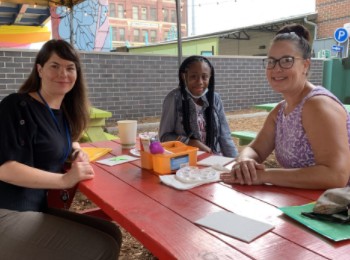 The news is filled with stories of employers having a hard time finding job candidates with the right skills. In many cases, the “right” skills do not necessarily refer to highly technical skills but, rather, to skills such as communication, collaboration, critical thinking, and creativity–or, the “Four Cs.” These can be developed through social and emotional learning (SEL), the process by which children and adults learn how to understand and manage emotions, set and achieve positive goals, feel and show empathy for others, establish and maintain positive relationships, and make responsible decisions.
The news is filled with stories of employers having a hard time finding job candidates with the right skills. In many cases, the “right” skills do not necessarily refer to highly technical skills but, rather, to skills such as communication, collaboration, critical thinking, and creativity–or, the “Four Cs.” These can be developed through social and emotional learning (SEL), the process by which children and adults learn how to understand and manage emotions, set and achieve positive goals, feel and show empathy for others, establish and maintain positive relationships, and make responsible decisions.
A Natural Fit for CTE and Postsecondary Transition Planning
Given the relationship between SEL and workforce readiness skills, SEL is a perfect fit for Career and Technical Education (CTE) as well as Postsecondary Transition Planning (PTP) for special education students. According to Stephanie O’Connor-Schutt, the School-to-Work Transition Program Supervisor for Milwaukee Public Schools (MPS), “It’s so natural to be providing this instruction. Our teachers are using the Wisconsin Common Career Technical Standards that focus on the Four Cs. So, they are teaching SEL without even realizing [it].” Further, in both CTE and PTP programs, educators can help students learn how to translate SEL skills into sought-after workplace skills.

Though SEL has long been a focus in education, the pandemic has accentuated the critical need to develop SEL competencies. “Before COVID, teachers would weave in SEL, but it might not have been as intentional. With being virtual last year, almost all of our teachers intentionally wove in SEL strategies. And, this is continuing now that we are back teaching face-to-face,” remarked Pam Lippert, Program Support Teacher for MPS’s School-to-Work Transition Program (STWTP).
Employers Learn Too
O’Connor-Schutt and Lippert have both noticed that the SEL focus is appreciated by the employers they work with, who often learn from it themselves. For example, last year after a conflict between two STWTP students, the school tapped the Violence Prevention Team to conduct a restorative circle with the students. Since the session also included teachers, the work supervisor asked to attend, too. After the session, everyone felt more empowered, more heard. It gave participants a common vocabulary and experience to use moving forward. In fact, the supervisor now plans to use restorative circles with her regular full-time employees because it is so effective.
The Link Between Postsecondary Transition Planning and CTE
To expand adoption of SEL, STWTP Social Worker Amanda Welcome developed a series of virtual SEL lessons. Realizing that these lessons could also benefit CTE educators, Milwaukee’s next step is to share their experiences, insight, and SEL lessons with fellow CTE colleagues. Thus, making an important connection between Special Education and CTE departments which is lacking in many districts. And, that is a win for their students.
–submitted by Karin Smith, CTE Consultant, Wisconsin Department of Public Instruction
“Help Wanted” photo by Nathan Dumlao on Unsplash